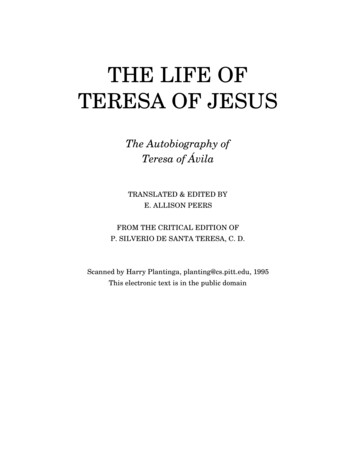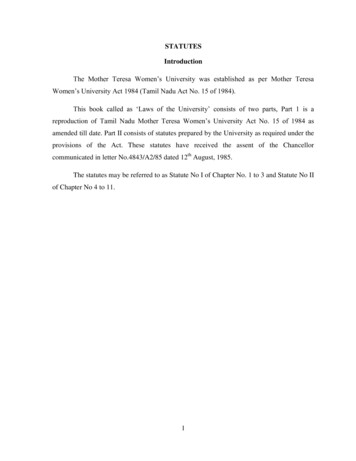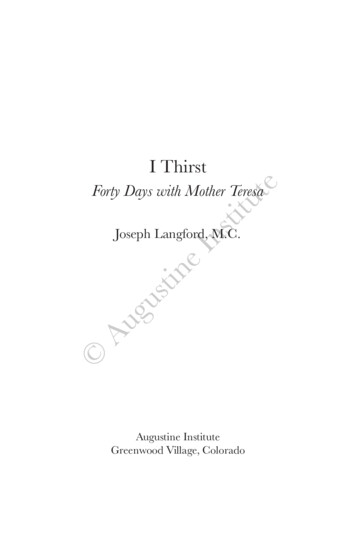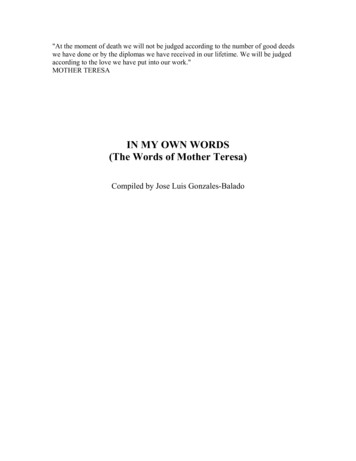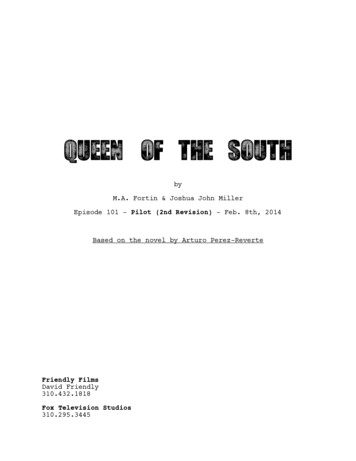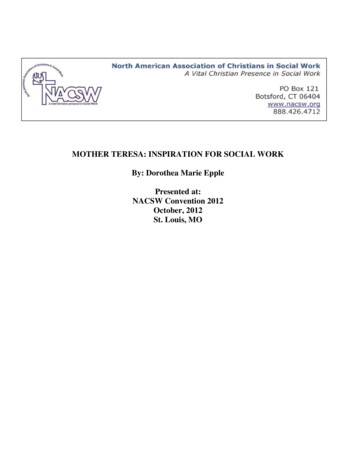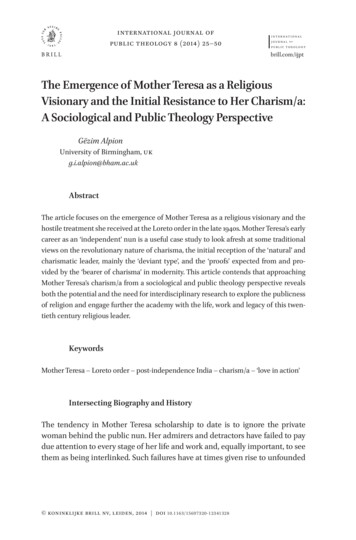
Transcription
Affect and Creativity atWorkTeresa M. AmabileHarvard UniversitySigal G. BarsadeUniversity of PennsylvaniaJennifer S. MuellerNew York UniversityBarry M. StawUniversity of California atBerkeley 2005 by Johnson Graduate School,Cornell University.0001-8392/05/5003-0367/ 3.00. The second, third, and fourth authors contributed equally; the order of their namesis alphabetical. This research was supported by the Harvard Business SchoolDivision of Research, as part of the multistudy research program entitled “TheT.E.A.M. Study: Events That InfluenceCreativity.” Earlier versions of this paperwere presented at the Academy of Management meetings, the University ofChicago, and Yale University. We gratefully acknowledge the help of several individuals in carrying out this research andpreparing this manuscript: Susan Archambault, Debbie Siegel, Rasheea Williams,Talia Grosser, Allison Bonk, ElizabethSchatzel, Dean Whitney, Jeremiah Weinstock, Steven Kramer, Jessica Tobiason,Giovanni Moneta, Lynn Miller, Tom Wojcik, Chelley Patterson, Mel Marsh, CandisCook, Paul Odomirok, Joyce Majewski,and Toby Stuart. We also thank JoePorac, Linda Johanson, and the anonymous ASQ reviewers for their helpfulinsights and comments.This study explored how affect relates to creativity atwork. Using both quantitative and qualitative longitudinaldata from the daily diaries of 222 employees in sevencompanies, we examined the nature, form, and temporaldynamics of the affect-creativity relationship. The resultsindicate that positive affect relates positively to creativityin organizations and that the relationship is a simple linear one. Time-lagged analyses identify positive affect asan antecedent of creative thought, with incubation periods of up to two days. Qualitative analyses identify positive affect as a consequence of creative thought events,as well as a concomitant of the creative process. A preliminary theory of the affect-creativity cycle in organizations includes each of these links and proposes mechanisms by which they may operate. Organizations are affectively laden environments. Not onlyhave theoretical reviews pointed to a prominent role foraffect in a range of organizational processes (Fineman, 1993;Brief and Weiss, 2002; Barsade, Brief, and Spataro, 2003),but recent empirical research has also begun to validateaffective influences on a number of work outcomes, including task quality, productivity, and efficiency (George, 1991;Staw and Barsade, 1993; Staw, Sutton, and Pelled, 1994).Relatively less attention has been paid, however, to organizational creativity as an outcome influenced by affect. Creativity—coming up with fresh ideas for changing products, services, and processes so as to better achieve theorganization’s goals—has been heralded as a key to enduringadvantage. Creative responses by employees at all levels inthe organization have therefore taken center stage in discussions of organizational innovation, and considerable researchhas been focused on factors that may foster or impede creativity in organizations (e.g., Amabile, 1988; Woodman,Sawyer, and Griffin, 1993; Ford, 1996; Oldham and Cummings, 1996). In spite of this high level of attention, however,there has been only limited progress in understanding therole of affect as an antecedent and consequence of creativityin the workplace.Creative activity appears to be an affectively charged event,one in which complex cognitive processes are shaped by, cooccur with, and shape emotional experience. The biographies, letters, and journals of well-known creative individualsabound with emotional drama. Popular literature has oftendescribed affective dysfunction as an ingredient of creativity,using stories of artists such as Vincent Van Gogh and SylviaPlath to illustrate the troubled life of the creative genius. Lesspublicized are the more positive images of creatives, such asthe mathematician Henri Poincare, who reported that heexperienced creative breakthroughs while on vacation,relaxed and comfortable (Vernon, 1970), or Mozart, whoclaimed that pleasant moods were most conducive to his creativity: “When I am, as it were, completely myself, entirelyalone, and of good cheer—say, traveling in a carriage, orwalking after a good meal, or during the night when I cannotsleep; it is on such occasions that my ideas flow best andmost abundantly” (Vernon, 1970: 55).367/Administrative Science Quarterly, 50 (2005): 367–403
An extensive experimental literature in psychology has examined the relationship between affective processes and cognition, including creative cognition, at single points in time (forreviews, see Fiedler and Forgas, 1988; Isen, 1999a, 1999b;Forgas, 2001). Although studies outside the laboratory arerare, some research using non-experimental methods toexamine affect and creativity in work organizations hasappeared in the recent literature (George and Zhou, 2002;Madjar, Oldham, and Pratt, 2002). But little is known abouthow naturally occurring affective experiences in the flow ofpeople’s daily work lives might relate to their creative thinking on the job, and there is a dearth of research on the affectcreativity relationship over time. Moreover, although a number of scholars have suggested mechanisms by which affectmight influence creativity, there is as yet no general theory ofthe reciprocal interplay between affect and creativity in organizations.Our study addresses these empirical and theoretical gaps byexploring the affect-creativity relationship in a number of different ways, using both quantitative and qualitative longitudinal data on affect and creativity in organizations. We investigate the nature and form of the relationship, examiningaffective valence (positivity-negativity), intensity, ambivalence, and lability. In addition, we take advantage of our longitudinal data to explore the temporal dynamics of affectiveexperience and creative thinking.THEORYCreativity is generally defined as the production of novel, useful ideas or problem solutions. It refers to both the process ofidea generation or problem solving and the actual idea orsolution (Amabile, 1983; Sternberg, 1988a; Weisberg, 1988).In his evolutionary theory of creative thinking, Simonton(1999) proposed a process of variation and selective retention, building not only on Darwin’s theory of organic evolutionbut also on Campbell’s (1960) evolutionary model of the creative process. Although it does not incorporate affect, Simonton’s theory is particularly useful for considering the relationship between affect and creative thought. In this theory, theprocess of variation primarily contributes to idea novelty, andthe process of selection primarily contributes to idea usefulness. Drawing on the assumption that novelty is the distinguishing feature of creative work over and above work that issolely useful or well done (Amabile, 1996), Simonton focusedhis theory on variation. In a significant modification of Campbell’s original ideas, Simonton suggested that variation neednot be (and usually is not) blind or random. Rather, it is guided by the existence of knowledge elements that are availablefor combination into new variations within the creator’s mind,by the extent to which the creator’s mind treats those elements as relevant to the problem at hand, and by heuristicprocesses for combining those elements.A central construct of Simonton’s theory is that the probability of novelty varies with the number of cognitive elementsavailable for association and with the breadth of those elements that are treated as relevant to the problem. The importance of the number and breadth of cognitive elements is368/ASQ, September 2005
Affect and Creativityhighlighted by other creativity theorists as well (Langley andJones, 1988; Sternberg, 1988b). Both of these aspects ofcognition should contribute to greater variation in idea possibilities, increasing the population of unusual possibilities fromwhich to choose in the selection process. According toSimonton, the initial selection of ideas goes on within themind of the individual creator, through a process of testingthem against relevant criteria for usefulness or appropriateness, as well as criteria for novelty. Once an idea has beenselected by the creator, developed, and communicated, thereis often a second selection process by relevant individuals ina social group or intellectual community. Thus, because creativity depends in large part on novelty, and because noveltyis largely a function of cognitive variation, anything within therange of normal cognition that increases variation is likely toincrease the probability of creativity. Affect is one source ofsuch variation.The Nature and Form of the Affect-Creativity RelationshipPositive affect and creativity. Some theories of affect suggest that creativity may be particularly susceptible to affective influence, mainly because positive affect leads to thesort of cognitive variation that stimulates creativity (Clore,Schwarz, and Conway, 1994). For example, Isen (1999a,1999b) proposed that positive affect has three primaryeffects on cognitive activity. First, positive affect makes additional cognitive material available for processing, increasingthe number of cognitive elements available for association.Second, it leads to defocused attention and a more complexcognitive context, increasing the breadth of those elementsthat are treated as relevant to the problem. Third, it increasescognitive flexibility, increasing the probability that diverse cognitive elements will in fact become associated. Isen concluded that, together, these processes lead positive affect tohave a positive influence on creativity.Similarly, in her broaden-and-build model of positive emotion,Fredrickson (1998, 2001) proposed that positive emotions,such as joy and love, broaden a person’s available repertoireof cognitions and actions. She noted that “experiences ofcertain positive emotions prompt individuals to discard timetested or automatic (everyday) behavioral scripts and to pursue novel, creative, and often unscripted paths of thoughtand action” (Fredrickson, 1998: 304). Fredrickson posited thatpositive emotions broaden the scope of attention (increasingthe number of cognitive elements available for association)and the scope of cognition (increasing the breadth of thoseelements that are treated as relevant to the problem). Theseare the same aspects of mental activity that, according to theevolutionary theory, should lead to greater variation and thusincrease the probability of creativity.The most extensive body of empirical support for a linkbetween positive affect and creativity comes from Isen’s(1999a, 1999b) program of laboratory research. In these studies, positive mood has been induced by a number of differentstimuli, including an event (such as the experimenter givingparticipants a treat or gift), a film clip (such as a comedy), oran excerpt of affect-laden music. The most consistent finding369/ASQ, September 2005
of these experiments has been that induced positive moodleads to higher levels of performance on dimensions relatingto creativity. For example, in three experiments with collegestudents, positive mood led to more unusual (but still appropriate) word associations (Isen et al., 1985). Similarly, in aseries of four experiments, positive mood positively influenced the performance of college students on a number ofingenuity tests (Isen, Daubman, and Nowicki, 1987; Estrada,Isen, and Young, 1994). Other studies have shown that subjects in happy moods display greater fluency, generatingmore responses and more divergent responses than subjectsin neutral or sad moods (Abele-Brehm, 1992; Hirt et al., 1996;Vosburg, 1998). Finally, experimentally induced positive moodhas led to enhanced performance on exercises requiring flexible problem solving, including tasks as diverse as groupingobjects (Isen and Daubman, 1984), grouping people (Isen,Niedenthal, and Cantor, 1992), and integrative bargainingexercises in which achieving the optimal win-win outcomerequires considerable exploration of alternatives (Carnevaleand Isen, 1986). Taken together, these empirical results provide substantial evidence that positive affect can inducechanges in cognitive processing that facilitate creativeactivity.Negative affect and creativity. Other theorists have suggested that negative affect leads to greater creativity. A cornerstone of this perspective is empirical evidence of a relationship between affective illness and creativity. In a study of1,005 prominent twentieth century individuals from over 45different professions, Ludwig (1992) found a slight but significant correlation between depression and level of creativeachievement. In addition, several systematic studies of highlycreative individuals and their relatives have uncovered a higher incidence of affective disorders (primarily bipolar illnessand depression) than that found in the general population(e.g., Andreasen, 1987; Jamison, 1993; Post, 1996). In arecent review of the literature over the past 30 years, Feist(1999) concluded that there is a reliable relationship betweenaffective illness and high levels of creative accomplishment,although he noted that the relationship applies primarily toartistic, not scientific, creativity.The possibility that negative affect might boost creativity innormal populations is suggested by the “mood-as-input”model of Martin and his colleagues (Martin et al., 1993). Thismodel posits that people use their current mood as an informational cue, with positive mood signaling that all is well,and negative mood signaling that something is amiss in thesituation. The result of this assessment can mean that people will stop working on tasks when they experience positiveaffect but will continue to be motivated on tasks when theyexperience negative affect. George and Zhou (2002) appliedthe mood-as-input model to creativity, proposing that theinformation provided by affective states can influence an individual’s effort and persistence on creative activities at work.They suggested that when people are experiencing positiveaffect, are aware of that affective state, and are in a situationthat clearly calls for creativity, they will interpret their positivemood as an indication that they have met their creative goal370/ASQ, September 2005
Affect and Creativityand additional effort is not needed. Thus, under these conditions, positive affect should be negatively related to creativity. By contrast, when people are experiencing negativeaffect, are aware of that affective state, and are in a situationthat clearly calls for creativity, they will interpret their negative mood as an indication that they must try harder to find acreative solution. The results of a cross-sectional study conducted in a large manufacturing organization supported thesehypotheses (George and Zhou, 2002), although an earlierexperimental study testing the mood-as-input model foundsupport only on quantitative aspects of performance and noton creativity (Hirt et al., 1997).Some laboratory experiments have found a facilitative effectof negative affect on creativity. Kaufmann and Vosburg (1997)found a negative influence of both naturally occurring andinduced positive affect on insight problems and a positiveinfluence of induced negative affect. Yet most experimentalstudies of mood and creativity have failed to find an impactof induced negative affect on creative performance (Isen andDaubman, 1984; Isen et al., 1985; Jausovec, 1989; Murray etal., 1990; Hirt et al., 1996; Grawtich, Munz, and Kramer,2003). For example, Isen, Daubman, and Nowicki (1987)found no influence of negative affect (but a positive influenceof positive affect) on essentially the same task as that usedby Kaufmann and Vosburg (1997). Moreover, one study ofnaturally occurring negative mood demonstrated an inverserelationship between negative mood and creativity (Vosburg,1998), and a field study (Madjar, Oldham, and Pratt, 2002)found no relationship between negative mood at work andcreativity.On balance, the empirical literature is more consistent in itssupport for a positive rather than a negative link betweenaffect and creativity, but because most of the research onaffect and creativity is laboratory-based, one must concludethat the relationship in organizational settings is still verymuch an open question. Therefore, this study will attempt tobring clarity to this issue through the use of extensive fielddata. We first address the sign of the simple relationshipbetween positive affect and work creativity: Is it positive ornegative? We then search for more complex patterns in therelationship, such as curvilinear effects of affective intensity,affective ambivalence effects, or affective lability effects.Curvilinear relationships between affect and creativity.The analyses employed in most prior empirical research inthis domain have assumed a linear relationship: higher levelsof affect relate to higher levels of creativity. But there is reason to believe the relationship might be curvilinear. For example, there might be a U-shaped relationship, whereby intensenegative or positive affect contributes to creativity, and moderate levels of affect are insufficient to stimulate the neededcognitive resources. Indirect support for this possibilityderives from neuropsychological research demonstrating thatintense emotional experiences enhance memory via stimulation of the amygdala, a brain region associated with cognitiveencoding (Canli et al., 2000; Cahill et al., 2004). A study ofautobiographic memory showed similar results (Talarico,LaBar, and Rubin, 2004). The emotional intensity of experi371/ASQ, September 2005
ences, whether they were positive or negative, led tostronger memories. Thus it may be that emotional intensity isbeneficial to creativity, given that enhanced memory is onemechanism that might contribute to the breadth or variabilityof cognitive activity.Alternatively, the affect-creativity relationship could follow aninverted U-shaped function (James, Brodersen, and Eisenberg, 2004). This possibility follows from the early theoreticalwork of Yerkes and Dodson (1908), who proposed anincrease in cognitive resources as arousal increases from lowto moderate levels and a decrease in mental efficiency asarousal exceeds the moderate optimum. In line with this reasoning, there may be a cognitive penalty for strong emotions,be they positive or negative. Frijda (1986) asserted that positive and negative emotions are both characterized by “controlprecedence,” such that emotions absorb available cognitiveresources because they require direct attention. Building onFrijda’s theory, Weiss and Cropanzano (1996: 54) stated that“people in an emotional state tend to be controlled by thatstate, they tend to be preoccupied by the emotion, and thereis a persistence to behaviors designed to deal with the emotion.” In this view, powerful emotions at work, both negativeand positive, may distract from task performance.Martindale’s (1999) neural network model of creativity proposes a similar pattern in creative performance. This modelsuggests that only in situations of lower than average arousalcan the mind attend to the associative connections necessary for novel ideas; under stronger arousal states, attentionis so focused on the arousal-inducing situation that innovativeassociations are less likely to come to awareness. Empiricalresearch has provided some support for this model. Forexample, Toplyn and Maguire (1991) found an inverted-U relationship when examining the effect of noise-induced stresson creative performance.Affective ambivalence. It is also possible that the simultaneous experience of positive and negative affect may stimulatecreativity by increasing the breadth of cognitive material available. According to mood congruency theory, a given moodstate can enhance the likelihood of recalling information thatwas encoded during a similar mood (Blaney, 1986). Thus, relative to states in which only a single emotion is experienced,simultaneously experiencing positive and negative emotionsmay serve to activate a greater number of memory nodes,thereby increasing both cognitive variability and creativity.Because memory nodes are associated with others in a network in which the most similar associations are the strongest(Bower, 1981), holding positive and negative emotions simultaneously may lead to a crossover between nodes that mayotherwise have been held separately in memory (Richards,1994). Some empirical evidence supports this view. Rothenberg (1990) reported that holding opposite or antitheticalthoughts in mind simultaneously increases the probabilitythat these opposing thoughts will be integrated into a newcreation. The same thing may happen with emotions, asdemonstrated in a recent laboratory study showing a positiveeffect of emotional ambivalence on creativity (Fong, 2003).372/ASQ, September 2005
Affect and CreativityAffective lability. Jamison (1993) suggested that changes inmood may be more important for creativity than static moodstates, particularly changes from negative to positive emotions. She offered as an example her study of British artists,who often described marked improvements in mood justprior to intense creative activity (Jamison, 1989). Jamison(1995: 67) suggested that affective lability enhances creativitybecause it “blends or harnesses seemingly contradictorymoods, observations, and perceptions.” Similarly, Prentky(1989) hypothesized a connection between affective labilityand “A-type” thinking, which is characterized by extensivescanning, rapidly incorporating very diverse pieces of information, and “erratic mental threshing” of that information. Suchtheoretical notions have generally been tested on clinical populations diagnosed with affective disorders. One such studyfound that the administration of lithium (for two consecutiveweeks) to patients with bipolar disorder decreased the number of associations made (assessed using various word association tests), while the discontinuation of lithium increasedthe production of associations (Shaw et al., 1986). Theauthors concluded that the administration of lithium mayhave “indirectly reduced creative productivity by eliminatingmood swings in patients dependent on such alterations forinspiration and energy” (p. 1166). Thus affective lability mayincrease the variety and breadth of associations generatedoverall, which provide an important input to the creativeprocess.Several theorists have questioned the logic of the proposedconnection between affective lability and creativity (Ludwig,1992), as well as its empirical basis (Waddell, 1998).Nonetheless, we searched for a relationship between affective lability and creativity in the present study because of theplausibility of the theoretical arguments, the demonstration ofaffect swings in non-clinical populations (Larsen, Diener, andEmmons, 1986), and the suggestive evidence of such a relationship in clinical populations.Temporal Dynamics of the Affect-Creativity RelationshipIn developing a preliminary theory of affect and creativity atwork, it is important to specify more than the basic form ofthe relationship between the two variables. It is also important to explore temporal aspects of the relationship: whetherpositive (or negative) mood, or change in mood, predictablyprecedes creativity; whether creativity predictably precedesmood; and whether affect and creativity occur simultaneously. Theoretically, these three patterns are not mutually exclusive; any and all may exist. In the present study, we takeadvantage of daily measures of mood and creativity acrossmany weeks to begin examining temporal aspects of therelationship.Affect as an antecedent of creativity. If, as suggested bythe experimental literature, positive mood enhances creativityat work, we would expect a given day’s creativity to followreliably from the previous day’s mood, above and beyond anycarry-over of that previous day’s mood. Theory and researchon “incubation,” long recognized as a part of the creativeprocess (Wallas, 1926; Simonton, 1999), suggest such cross373/ASQ, September 2005
day effects. Incubation is a process of unconscious recombination of thought elements that were stimulated throughconscious work at one point in time, resulting in novel anduseful ideas at some later point in time. Anecdotal reports ofincubation effects in creativity abound, ranging from Kekule’sdreaming the structure of the benzene ring to Poincare’s sudden mathematical insight in boarding a train while on vacation(Vernon, 1970; Mazzarello, 2000; Maquet and Ruby, 2004).Thus if positive mood on a particular day increases the number and scope of available thoughts, those additionalthoughts may incubate overnight, increasing the probability ofcreative thoughts the following day.Recent advances in neuroscience provide intriguing evidenceof the mechanisms underlying incubation effects, particularlythose that occur during sleep. This research reveals that people’s experiences while awake can be consolidated intomemory and result in enhanced performance the next daywithout any additional practice or engagement in the task(Karni et al., 1994; Maquet et al., 2000; Stickgold, James, andHobson, 2000; Walker et al., 2003; Gaab et al., 2004). Moreover, there is mounting evidence that sleep can facilitate thetypes of memory and learning processes, such as associativememory (Stickgold et al., 1999), that contribute to creativeproblem solving (Stickgold and Walker, 2004). In a particularlyrelevant experiment, Wagner and colleagues (2004) demonstrated that problem solving insight can be dramaticallyenhanced by a period of sleep following initial work on aproblem. After practice in doing a mathematical task that hada clue embedded within it, 59 percent of participants whoslept for an intervening eight hours gained insight into theproblem via the embedded clue, even though they had notbeen told that the clue existed, nor were they aware of theclue upon waking. By contrast, in the four control groups thatdid not have an intervening night’s sleep, at most only 25percent of participants gained insight into the problem.An interesting question for the incubation of creativity is howlong such an incubation period lasts. Theoretically, the incubation period can vary from a very brief period (e.g., a fewmoments) to days or weeks. Neuroscience researchersexamining incubation effects on learning have found thatmost of the learning occurs during the first night of sleepafter training but that improvement can continue for up toanother four nights (Stickgold, James, and Hobson, 2000;Walker et al., 2003; Atienza, Cantero, and Stickgold, 2004). Toour knowledge, there has not yet been any research on incubation effects in organizational creativity. Our longitudinaldata allow us to address this gap. If the broadened cognitiveassociations initiated by positive moods incubate over spansof one night or more, we should be able to detect an effectof one day’s mood on the next day’s creative thinking (aboveand beyond the effects of the next day’s mood). Moreover,by examining time lags of various lengths, we can begin tospecify the typical length of the creative incubation period inorganizational settings.Affect as a consequence of creativity. Not only might affectprecede creativity, but creative outcomes might provokeaffect as well. At its simplest level, the experience of creativi374/ASQ, September 2005
Affect and Creativityty is itself a work event, and like other events in the organizational context, it could evoke emotion (Weiss and Cropanzano, 1996). Qualitative research and anecdotal first-personaccounts of creative achievement in the arts and sciencessuggest that creative insight is often followed by feelings ofelation (Gruber, 1995; Feist, 1999; Shaw, 1999). For example,Einstein called his 1907 general theory of relativity “the happiest thought of my life” (Rothenberg, 1990: 14). Systematicempirical evidence on this matter is still very tentative, however. In a direct test of whether mood is altered by doing acreative task, Feist (1994) found that college students interested in art experienced an increase in positive mood afterengaging in an artistic creativity task; there was no sucheffect for science students after engaging in a scientific creativity task.In contrast to the possible incubation effects of affectivestate on subsequent creativity, the affective consequences ofcreativity are likely to be more direct and immediate. In general, affective events provoke immediate and relatively fleeting emotional reactions (Frijda, 1993; Frijda and Mesquita,1994; Oatley and Jenkins, 1996; Russell and Barrett, 1999).Thus, if creative performance at work is an affective eventfor the individual doing the creative work, such an effectwould likely be evident only in same-day data. Our daily qualitative data allow us to put this logic to an empirical test.The simultaneity of affect and creativity. In considering thetemporal links between affect and creativity, one must alsoinclude the possibility of simultaneity. As Sandelands (1988:439) noted, “Feeling and doing are coexistent, coterminous,and coordinate. Feeling merges with doing and is experienced as a quality of its form.” Such work feelings may beclosely tied to the creative experience itself. Csikszentmihalyi(1975, 1996) suggested that creative behavior is often characterized by a “flow state,” a temporary psychological merger of the person with the activity, which inherently involvespositive feelings such as enjoyment and enthusiasm. Conceptually, these feelings are similar to those described ascomponents of intrinsic motivation (Deci and Ryan, 1985):feeling passionately involved with the work, deeply interested in it, positively challenged by it, and enjoying it as it isunfolding. A considerable research literature has identifiedintrinsic motivation as the form of motivation that is mostcl
ed that, together, these processes lead positive affect to have a positive influence on creativity. Similarly, in her broaden-and-build model of positive emotion, Fredrickson (1998, 2001) proposed that positive emotions, such as joy and love, broaden a person's available repertoire of cognitions and actions. She noted that "experiences of
